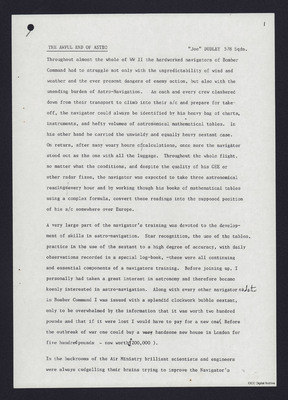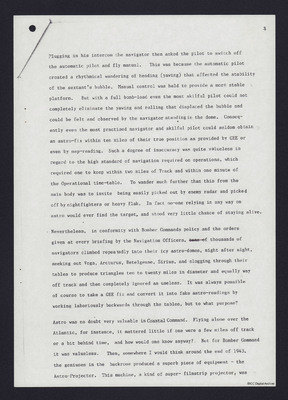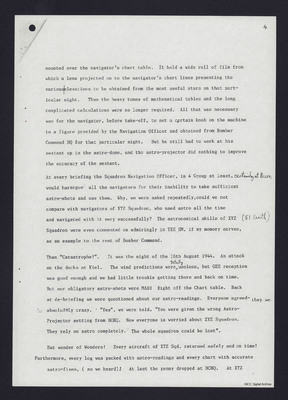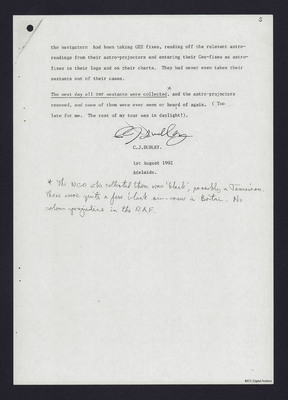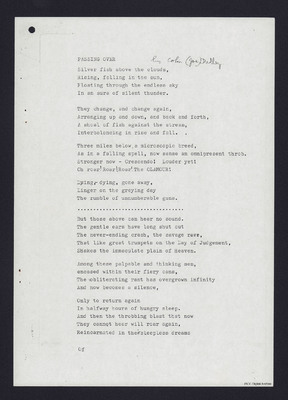The Awful End of Astro
Title
The Awful End of Astro
Description
An explanation of the end of astro-navigation on board bomber aircraft in addition to GEE navigation. Navigators were required to carry sextants and take three astro readings every hour. One night the wrong astro-projector settings were supplied and every navigator used GEE to locate the target. One crew's navigator had filled in the astro-navigation readings regardless (based on their GEE readings). That was the last night astro was used and the sextants were collected in.
Includes a copy of the poem 'Passing over'.
Includes a copy of the poem 'Passing over'.
Creator
Date
1992-08-01
Temporal Coverage
Language
Format
Six typewritten sheets
Publisher
Rights
This content is available under a CC BY-NC 4.0 International license (Creative Commons Attribution-NonCommercial 4.0). It has been published ‘as is’ and may contain inaccuracies or culturally inappropriate references that do not necessarily reflect the official policy or position of the University of Lincoln or the International Bomber Command Centre. For more information, visit https://creativecommons.org/licenses/by-nc/4.0/ and https://ibccdigitalarchive.lincoln.ac.uk/omeka/legal.
Contributor
Identifier
MAllenJH179996-160512-030001,
MAllenJH179996-160512-030002,
MAllenJH179996-160512-030003,
MAllenJH179996-160512-030004,
MAllenJH179996-160512-030005,
MAllenJH179996-160512-030006
MAllenJH179996-160512-030002,
MAllenJH179996-160512-030003,
MAllenJH179996-160512-030004,
MAllenJH179996-160512-030005,
MAllenJH179996-160512-030006
Transcription
1
[underlined] THE AWFUL END OF ASTRO [/underlined]
“Joe” DUDLEY 578 Sqdn.
Throughout almost the whole of WW II the hardworked (sic) navigators of Bomber Command had to struggle not only with the unpredictability of wind and weather and the ever present dangers of enemy action, but also with the unending burden of Astro-Navigation. As each and every crew clambered down from their transport to climb into their a/c and prepare for take-off, the navigator could always be identified by his heavy bag of charts, instruments, and hefty volumes of astronomical mathematical tables. In his other hand he carried the unwieldy and equally heavy sextant case.
On return, after many weary hours of calculations, once more the navigator stood out as soon as the one with all the luggage. Throughout the whole flight, no matter what the conditions, and despite the quality of his GEE or other radar fixes, the navigator was expected to take three astronomical readings every hour and by working through his books of mathematical tables using a complex formula, convert these reading into the supposed position of his a/c somewhere over Europe.
A very large part of the navigator’s training was devoted to the development of skills in astro-navigation. Star recognition, the use of the tables, practice in the use of the sextant to a high degree of accuracy, with daily observations recorded in a special log-book, - these were all continuing and essential components of a navigators training. Before joining up, I personally had taken a great interest in astronomy and therefore became keenly interested in astro-navigation.
Along with every other navigator [insert] cadet [/insert] in Bomber Command I was issued with a splendid clockwork bubble sextant, only to be overwhelmed by the information that it was worth two hundred pounds and that if it were lost I would have to pay for a new one. (Before the outbreak of war one could buy a [deleted] very [/deleted] handsome new house in London for five hundred pounds – now worth [insert] £ [/insert] 200,000).
In the backrooms of the Air Ministry brilliant scientists and engineers were always cudgelling their brains trying to improve the Navigator’s
Page break
2
Astro equipment. The bubble sextant, which used a kind of spirit level instead of an horizon, was probably a pre-war invention, but the clockwork mechanism that recorded a considerable number of readings over about half a minute and averaged them out, was certainly a war-time development.
The top brass in Bomber Command had what were regarded, quite reasonably, as very sound reasons for developing astro-navigation and pressing for its implementation on Ops. For one thing it had been used for centuries at sea all over the world. Secondly, and most persuasively, it could not be jammed like GEE and other radio devices. Nor could it be homed onto by enemy a/c as could H2S.
On the ground, in the open air, and no doubt at sea in calm weather, it was possible to obtain sextant readings of sun, moon and stats that could be plotted within one mile of one’s known position on the map. The observed diameter of the sun and moon is about 30 minutes of arc. If one could adjust one’s sextant to position the centre of the bubble within one thirtieth of the sun’s diameter to the centre of the sun, one could draw a line on one’s chart within one mile of one’s true position. But it took a lot of practice! To obtain a ‘fix’ one needed to take readings of the elevation of three well-placed stars. recording (sic) the exact time of each reading. The three readings, after much calculation, and allowing for the distances travelled between reading, would provide a triangle of lines on one’s chart the centre of which would be taken as one’s most probable position. On the ground! In the open air! But three or four miles up in a heavy bomber with a full bomb-load it was a very different matter.
After carrying out his normal navigation procedures, usually on GEE, the navigator would unpack his sextant, climb up into the astro-dome some way aft, and hook it on to a hook in the top of the dome. This was to ensure that the observations would be taken from the geometrical centre of the Perspex dome thus avoiding any refractive errors.
Page break
3
Plugging in his intercom the navigator then asked the pilot to switch off the automatic pilot and fly manual. This was because the automatic pilot created a rhythmical wandering of heading (yawing) that effected the stability of the sextant’s bubble. Manual control was held to provide a more stable platform. But with a full bomb-load even the most skilful pilot could not completely eliminate the yawing and rolling that displaced the bubble and could be felt and observed by the navigator standing in the dome. Consequently even the most practised navigator and skilful pilot could seldom obtain an astro-fix within ten miles of their true position as provided by GEE or even by map-reading.
Such a degree of inaccuracy was quite valueless in regard to the high standard of navigation required on operations, which required one to keep within two miles of Track and within one minute of the Operational time-table. To wander much further than this from the main body was to invite being easily picked out by enemy radar and picked off by nightfighters or heavy flak. In fact no-one relying in any way on astro would ever find the target, and stood very little chance of staying alive.
Nevertheless, in conformity with Bomber Commands policy and the orders given at every briefing by the Navigation Officers, [deleted] tens of [/deleted] thousands of navigators climbed repeatedly into their icy astro-domes, night , after night, seeking out Vega, Arcturus, Betelgeuse, Sirius, and slogging through their tables to produce triangles ten to twenty miles in diameter and equally way off track and then completely ignored as useless. It was always possible of course to take a GEE fix and convert it into fake astro -readings by working laboriously backwards through the tables, but to what purpose?
Astro was no doubt very valuable in Coastal Command. Flying alone over the Atlantic, for instance, it mattered little if one were a few miles off track or a bit behind time, and how would anyone know anyway? But for Bomber Command it was valueless. Then, somewhere I would think around the end of 1943, the geniuses in the backroom - produced a superb piece of equipment – the Astro-Projector. This machine, a kind of super- filmstrip projector, was
Page break
4
mounted over the navigator’s chart table. It held a wide roll of film from which a lens projected on to the navigator’s chart lines presenting the various elevation to be obtained from the most useful stars on that particular night. Thus the heavy tomes of mathematical tables and the long complicated calculations were no longer required. All that was necessary was for the navigator, before take-off, to set a certain knob on the machine to a figure provided by the navigation Officer and obtained from Bomber Command HQ for that particular night. But he still had to work at his sextant set up in the astro-dome, and the astro-projector did nothing to improve the accuracy of the sextant.
At every briefing the Squadron Navigation Officer, in 4 Group at least, [insert] certainly at Burn [/insert] would harangue all the navigators for their inability to take sufficient astro-shots and use them. Why, we were asked repeatedly, could we not compare with the navigators of XYZ Squadron, who used astro all the time and navigated with it very successfully? The astronomical skills of XYZ [insert] 51 Smith [/insert] Squadron were even commented on admiringly in TEE EM, if my memory serves, as an example to the rest of Bomber Command.
Then “Catastrophe!”. It was the night of the 16th August 1944. An attack on the docks at Kiel. The wind predictions were [insert] totally [/insert] useless, but GEE reception was good enough and we had little trouble getting there and back on time.
But our obligatory astro-shots were MAD! Right off the Chart table. Back at de-briefing we were questioned about our astro-readings. Everyone agreed - they were absolutely crazy. “Yes”, we were told. “You were given the wrong Astro-Projector setting from BCHQ. Now everyone is worried about XYZ Squadron. They rely on astro completely. The whole squadron could be lost”.
But wonder of Wonders! (sic) Every aircraft of XYZ Sqd. returned safely and on time! Furthermore, every log was packed with astro-reading and every chart with accurate astro-fixes, (so we heard)! At last the penny dropped at BCHQ. At XYZ
Page break
5
The navigators had been taking GEE fixes, reading off the relevant astro-readings from their astro-projectors and entering their Gee-fixes as astro-fixes in their logs and on their charts. They had never even taken their sextants out of their cases.
[underlined] The next day all our sextants were collected. [/underlined] [insert] * [/insert] and the astro-projectors removed, and none of them were ever seen or heard of again. (Too late for me. The rest of my tour was in daylight!).
[signature]
C.J.DUDLEY.
1st August 1992
Adelaide.
[insert] * The NCO who collected them was ‘black’, possibly a Jamaican. There were quite a few black air-crew in Britain. No colour-prejudice in the R.A.F.
Page break
PASSING OVER
[insert] by Colin (Joe) Dudley [/insert]
Silver fish above the clouds,
Rising, falling in the sun,
Floating through the endless sky
In an aura of silent thunder.
They change, and change again,
Arranging up and down, and back and forth,
A shoal of fish against the stream,
Interbalancing (sic) in rise and fall.
Three miles below a microscopic breed,
As in a falling spell, now sense an omnipresent throb
Stronger now – Crescendo! Louder yet!
Oh roar! Roar! Roar! The CLAMOUR!
Dying, dying, gone away,
Linger on the greying day
The rumble of unnumberable guns.
………………………………….
But those above can hear no sound.
The gentle ears have long shut out
The never-ending crash, the savage rave,
That like great trumpets on the Day of Judgement.
Shakes the immaculate plain of Heaven.
Among these palpable and thinking men,
Encased within their fiery cans,
The obliterating rant has overgrown infinity
And now becomes a silence,
Only to return again
In halfway hours of hungry sleep.
And then the throbbing blast that now
They cannot hear will roar again,
Reincarnated in their sleepless dreams
Of
[underlined] THE AWFUL END OF ASTRO [/underlined]
“Joe” DUDLEY 578 Sqdn.
Throughout almost the whole of WW II the hardworked (sic) navigators of Bomber Command had to struggle not only with the unpredictability of wind and weather and the ever present dangers of enemy action, but also with the unending burden of Astro-Navigation. As each and every crew clambered down from their transport to climb into their a/c and prepare for take-off, the navigator could always be identified by his heavy bag of charts, instruments, and hefty volumes of astronomical mathematical tables. In his other hand he carried the unwieldy and equally heavy sextant case.
On return, after many weary hours of calculations, once more the navigator stood out as soon as the one with all the luggage. Throughout the whole flight, no matter what the conditions, and despite the quality of his GEE or other radar fixes, the navigator was expected to take three astronomical readings every hour and by working through his books of mathematical tables using a complex formula, convert these reading into the supposed position of his a/c somewhere over Europe.
A very large part of the navigator’s training was devoted to the development of skills in astro-navigation. Star recognition, the use of the tables, practice in the use of the sextant to a high degree of accuracy, with daily observations recorded in a special log-book, - these were all continuing and essential components of a navigators training. Before joining up, I personally had taken a great interest in astronomy and therefore became keenly interested in astro-navigation.
Along with every other navigator [insert] cadet [/insert] in Bomber Command I was issued with a splendid clockwork bubble sextant, only to be overwhelmed by the information that it was worth two hundred pounds and that if it were lost I would have to pay for a new one. (Before the outbreak of war one could buy a [deleted] very [/deleted] handsome new house in London for five hundred pounds – now worth [insert] £ [/insert] 200,000).
In the backrooms of the Air Ministry brilliant scientists and engineers were always cudgelling their brains trying to improve the Navigator’s
Page break
2
Astro equipment. The bubble sextant, which used a kind of spirit level instead of an horizon, was probably a pre-war invention, but the clockwork mechanism that recorded a considerable number of readings over about half a minute and averaged them out, was certainly a war-time development.
The top brass in Bomber Command had what were regarded, quite reasonably, as very sound reasons for developing astro-navigation and pressing for its implementation on Ops. For one thing it had been used for centuries at sea all over the world. Secondly, and most persuasively, it could not be jammed like GEE and other radio devices. Nor could it be homed onto by enemy a/c as could H2S.
On the ground, in the open air, and no doubt at sea in calm weather, it was possible to obtain sextant readings of sun, moon and stats that could be plotted within one mile of one’s known position on the map. The observed diameter of the sun and moon is about 30 minutes of arc. If one could adjust one’s sextant to position the centre of the bubble within one thirtieth of the sun’s diameter to the centre of the sun, one could draw a line on one’s chart within one mile of one’s true position. But it took a lot of practice! To obtain a ‘fix’ one needed to take readings of the elevation of three well-placed stars. recording (sic) the exact time of each reading. The three readings, after much calculation, and allowing for the distances travelled between reading, would provide a triangle of lines on one’s chart the centre of which would be taken as one’s most probable position. On the ground! In the open air! But three or four miles up in a heavy bomber with a full bomb-load it was a very different matter.
After carrying out his normal navigation procedures, usually on GEE, the navigator would unpack his sextant, climb up into the astro-dome some way aft, and hook it on to a hook in the top of the dome. This was to ensure that the observations would be taken from the geometrical centre of the Perspex dome thus avoiding any refractive errors.
Page break
3
Plugging in his intercom the navigator then asked the pilot to switch off the automatic pilot and fly manual. This was because the automatic pilot created a rhythmical wandering of heading (yawing) that effected the stability of the sextant’s bubble. Manual control was held to provide a more stable platform. But with a full bomb-load even the most skilful pilot could not completely eliminate the yawing and rolling that displaced the bubble and could be felt and observed by the navigator standing in the dome. Consequently even the most practised navigator and skilful pilot could seldom obtain an astro-fix within ten miles of their true position as provided by GEE or even by map-reading.
Such a degree of inaccuracy was quite valueless in regard to the high standard of navigation required on operations, which required one to keep within two miles of Track and within one minute of the Operational time-table. To wander much further than this from the main body was to invite being easily picked out by enemy radar and picked off by nightfighters or heavy flak. In fact no-one relying in any way on astro would ever find the target, and stood very little chance of staying alive.
Nevertheless, in conformity with Bomber Commands policy and the orders given at every briefing by the Navigation Officers, [deleted] tens of [/deleted] thousands of navigators climbed repeatedly into their icy astro-domes, night , after night, seeking out Vega, Arcturus, Betelgeuse, Sirius, and slogging through their tables to produce triangles ten to twenty miles in diameter and equally way off track and then completely ignored as useless. It was always possible of course to take a GEE fix and convert it into fake astro -readings by working laboriously backwards through the tables, but to what purpose?
Astro was no doubt very valuable in Coastal Command. Flying alone over the Atlantic, for instance, it mattered little if one were a few miles off track or a bit behind time, and how would anyone know anyway? But for Bomber Command it was valueless. Then, somewhere I would think around the end of 1943, the geniuses in the backroom - produced a superb piece of equipment – the Astro-Projector. This machine, a kind of super- filmstrip projector, was
Page break
4
mounted over the navigator’s chart table. It held a wide roll of film from which a lens projected on to the navigator’s chart lines presenting the various elevation to be obtained from the most useful stars on that particular night. Thus the heavy tomes of mathematical tables and the long complicated calculations were no longer required. All that was necessary was for the navigator, before take-off, to set a certain knob on the machine to a figure provided by the navigation Officer and obtained from Bomber Command HQ for that particular night. But he still had to work at his sextant set up in the astro-dome, and the astro-projector did nothing to improve the accuracy of the sextant.
At every briefing the Squadron Navigation Officer, in 4 Group at least, [insert] certainly at Burn [/insert] would harangue all the navigators for their inability to take sufficient astro-shots and use them. Why, we were asked repeatedly, could we not compare with the navigators of XYZ Squadron, who used astro all the time and navigated with it very successfully? The astronomical skills of XYZ [insert] 51 Smith [/insert] Squadron were even commented on admiringly in TEE EM, if my memory serves, as an example to the rest of Bomber Command.
Then “Catastrophe!”. It was the night of the 16th August 1944. An attack on the docks at Kiel. The wind predictions were [insert] totally [/insert] useless, but GEE reception was good enough and we had little trouble getting there and back on time.
But our obligatory astro-shots were MAD! Right off the Chart table. Back at de-briefing we were questioned about our astro-readings. Everyone agreed - they were absolutely crazy. “Yes”, we were told. “You were given the wrong Astro-Projector setting from BCHQ. Now everyone is worried about XYZ Squadron. They rely on astro completely. The whole squadron could be lost”.
But wonder of Wonders! (sic) Every aircraft of XYZ Sqd. returned safely and on time! Furthermore, every log was packed with astro-reading and every chart with accurate astro-fixes, (so we heard)! At last the penny dropped at BCHQ. At XYZ
Page break
5
The navigators had been taking GEE fixes, reading off the relevant astro-readings from their astro-projectors and entering their Gee-fixes as astro-fixes in their logs and on their charts. They had never even taken their sextants out of their cases.
[underlined] The next day all our sextants were collected. [/underlined] [insert] * [/insert] and the astro-projectors removed, and none of them were ever seen or heard of again. (Too late for me. The rest of my tour was in daylight!).
[signature]
C.J.DUDLEY.
1st August 1992
Adelaide.
[insert] * The NCO who collected them was ‘black’, possibly a Jamaican. There were quite a few black air-crew in Britain. No colour-prejudice in the R.A.F.
Page break
PASSING OVER
[insert] by Colin (Joe) Dudley [/insert]
Silver fish above the clouds,
Rising, falling in the sun,
Floating through the endless sky
In an aura of silent thunder.
They change, and change again,
Arranging up and down, and back and forth,
A shoal of fish against the stream,
Interbalancing (sic) in rise and fall.
Three miles below a microscopic breed,
As in a falling spell, now sense an omnipresent throb
Stronger now – Crescendo! Louder yet!
Oh roar! Roar! Roar! The CLAMOUR!
Dying, dying, gone away,
Linger on the greying day
The rumble of unnumberable guns.
………………………………….
But those above can hear no sound.
The gentle ears have long shut out
The never-ending crash, the savage rave,
That like great trumpets on the Day of Judgement.
Shakes the immaculate plain of Heaven.
Among these palpable and thinking men,
Encased within their fiery cans,
The obliterating rant has overgrown infinity
And now becomes a silence,
Only to return again
In halfway hours of hungry sleep.
And then the throbbing blast that now
They cannot hear will roar again,
Reincarnated in their sleepless dreams
Of
Collection
Citation
Joe Dudley, “The Awful End of Astro,” IBCC Digital Archive, accessed July 23, 2024, https://ibccdigitalarchive.lincoln.ac.uk/omeka/collections/document/16302.
Item Relations
| This Item | dcterms:relation | Item: Passing over |

